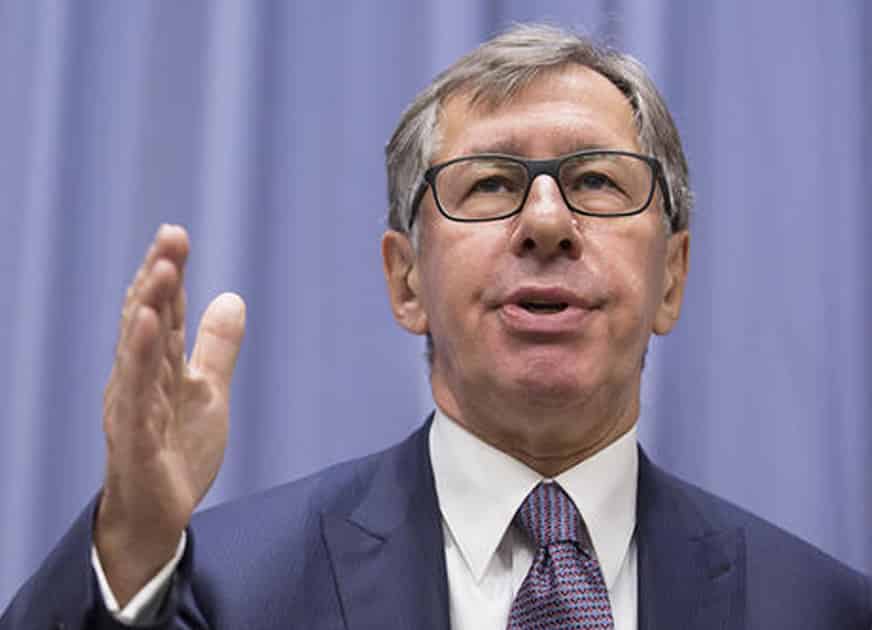News by
YaleNews on
After the collapse of the Soviet Union, a team of young economic reformers led by Yegor Gaidar worked to create a new economic future for Russia. Against the overwhelming threat of looming hunger and civil war they created a market economy that remains in place today.
As an economist and one of the market reformers, Petr Aven, served as Russia’s minister of foreign economic relations at the time. He played an important role in transforming Russia from a centrally planned to a new market economy.
Speaking to students of Economics 122 in the auditorium of Henry R. Luce Hall, Aven shared his experiences from that turbulent period.
William Nordhaus, Sterling Professor of Economics and the class’s instructor, urged his students to consider the unprecedented nature of the challenge Aven and his colleagues faced.
“There was no playbook for it,” he said.
Aven said it was clear by the 1970s that the Soviet Union’s centralized economic system, which was based on the military industry and energy production, was poorly equipped to compete with the diversifying economies of western nations.
Oil production had sustained the Soviet economy until oil prices plummeted in 1980s, which caused an economic collapse Aven said.
“It was basically a catastrophe,” said Aven, an international businessman who is no longer involved in politics.
The Soviet leadership under Mikhail Gorbachev took measures to improve management of the economic system by reducing expenditure but was incapable making the deep institutional reforms needed to revive the economy, Aven said.
Aven, who was a young economist and researcher at the time, described a trip he made to a region in Siberia in 1987 to learn how communist party leaders there set the annual plans for the area’s collective farms.
The farm managers engaged in negotiations with party bosses over annual yield projections using entirely imaginary figures, he said, adding that the goal was to avoid making the lowest or the highest projection.
“It was just a game,” he said. “Whatever they agreed determined the amount of fertilizer and the number of tractors they received”.
In 1989, staples like milk, bread, and sugar were not available at stores and it was clear that massive reform was required, Aven said.
“For the first time, we were seeing empty shelves,” he said, which undermined the notion that the socialist state could meet people’s basic needs.
Years earlier, Aven and his economic reformer colleagues, foreseeing the economic system’s collapse, had begun brainstorming about how best to replace it, he said. He said they had even looked at Sweden as an alternative economic model as a good example of what could be achieved, but decided it was too socialist for Russia.
Aven said that by 1990 they had begun to consult with foreign academics, including Nordhaus and the late Merton J. Peck, who was chair of Yale’s Department of Economics at the time.
Aven referenced “What Is to Be Done?” — a 1992 book by Peck, Nordhaus, and several of their colleagues that laid out proposals for transitioning Russia and former Soviet republics to a functioning market economy. He said the ideas described in the book formed a blueprint for the reformers.
After the Soviet regime collapsed, President Boris Yeltsin appointed Aven to assist in the transition to a market economy, specifically assigning him to make the ruble convertible and find a solution to Russia’s foreign debt.
Aven recalled giving a presentation to hundreds of people explaining that in two months time the ruble would become convertible and that anyone would be able to exchange rubles for dollars.
“They laughed at what I was saying,” he said, “I was a young 36 year old economist explaining to people who had lived more 70 years under the communist regime — in which hard currency was outlawed — that roubles could be exchanged for dollars. They could not grasp the notion of exchanging rubles for American dollars.
“You had to be absolutely sure that what you proposed was true because everyone was against it,” he said of implementing the reforms.
Asked by a student what the economic reformers would do differently if given the chance, Aven said— the loans for shares program instituted after he had stepped down and joined the private sector — had been a terrible mistake. He said the unfair method by which state-owned assets were privatized was the transition’s greatest error.
“Big pieces of state property were given away for nothing to some people very unfairly,” he said. “It had the psychological effect of undermining the transition to the market economy and was used repeatedly by those set on undermining broader economic reform.”
Aven emphasized that the transition to the market economy, despite challenges and criticism of the country’s current political leadership, has undeniably benefited the Russian people.
“Just to be frank, the quality of life in Russia today in incomparably better than it was 25 years ago,” he said. “But there is still a considerable way to go. In 1917 Russia was the world’s 5th largest economy producing about 8-9% world GDP. Today Russia is 12th largest economy in the world with about 1.7% GDP. “
Comments
Add comment